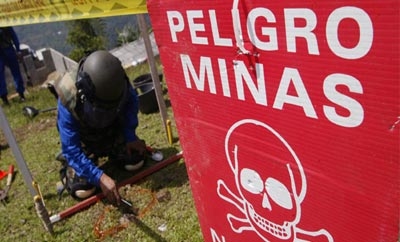Colombia’s criminal hybrid groups, known as BACRIM, are reportedly using landmines to protect their criminal interests in north Colombia, marking a change in their military tactics that has worrying long-term implications.
According to sources in the security forces consulted by El Tiempo, BACRIM (which comes from the Spanish “bandas criminales,” or “criminal bands”) in the provinces of Antioquia and Cordoba have been planting mines to protect coca crops, drug trafficking corridors and illegal mining interests.
One of the most affected areas is the region known as the Nudo de Paramillo in northern Antioquia, where landmines have injured six soldiers so far this year. According to the authorities, Colombia’s most powerful BACRIM, the Urabeños, are using makeshift mines in their dispute for control of the estimated 1,850 hectares of coca planted in the area’s national park.
They are not alone. Guerrillas of the Revolutionary Armed Forces of Colombia (FARC) have also laid landmines in the area.
In the Bajo Cauca region, also in Antioquia, communities have also reported that the BACRIM — along with the FARC and the smaller guerrilla group, the National Liberation Army (ELN) — have been planting mines on paths used by the civilian population.
There have been further reports of the BACRIM using mines in the departments of Magdalena and Valle del Cauca.
InSight Crime Analysis
The BACRIM use of landmines makes sense: they are hybrid organizations that need to control territory in order to make money. Their principal function in the cocaine distribution chain is protecting coca crops, processing the coca into cocaine, and securing the cocaine’s passage to port for export. They also make money extracting minerals illegally and levying “protection taxes” on those that mine legally or illegally.
In recent months, numerous BACRIM leaders have been captured or killed pushing some of the lower echelons to drastic measures to maintain their market share. Landmines appear to be part of this strategy.
Know how to build mines is embedded in the BACRIM. The paramilitary forerunners of the BACRIM, the United Self-Defense Forces of Colombia (AUC), were known to use landmines, although in far few numbers than their guerrilla counterparts. A Landmine Monitor Report,published at the peak of the AUC’s power,showed that in 2002, 37 percent of the 638 reported landmine incidents were caused by mines believed to have been planted by the FARC, compared to just 1.2 percent by the AUC. In 44 percent of the cases, it was not known which group was responsible (read full report in pdfform).
The use of mines in Colombia is commonly linked to guerrilla groups, especially the FARC, leading some to speculate that there has been a knowledge transfer from the rebels to the BACRIM. Over the course of their half century-long war against the state, the guerrillas have strewn tens of thousands of mines around the country, mainly as a cheap and devastatingly effective way of slowing a military advance. In recent years, the insurgents have also used mines to protect their coca crops, as the Colombian government has moved towards increased manual coca eradication following controversy over the side effects of aerial spraying.
Despite the reports of conflict between the rebels and the BACRIM in some of the regions involved, it has become increasingly common for both the FARC and the ELN to forge temporary alliances with their former paramilitary enemies, based around shared criminal interests. In some instances, the guerrillas were reportedly training the BACRIM. Notably, in 2011, police in Bolivar department claimed the FARC were training the Rastrojos how to make landmines.
Last year, Colombia recorded its 10,000th landmine victim since 1990, giving it the world’s second highest landmine casualty rate after Afghanistan, and many in Colombia have been hoping that a successful peace process with the FARC would enable Colombia to begin the long and arduous process of removing the landmine death traps strewn around the country. However, the revelation of BACRIM use of landmines illustrates the blurring of the lines between the guerrillas and the BACRIM in both tactics and criminal interests, which does not bode well for hopes that a FARC demobilization would bring peace overnight to Colombia.

